Compost Tumblers – Pros and Cons – Best Tumbling Composters
This post may contain affiliate links. Read my full disclosure here.
Do you want to make compost, but don’t want the hassle of turning a compost pile, or the mess of open bins? Then a compost tumbler may be right for you.
We’ll discuss which compost tumbler is best for different households, pros and cons, and how to use a tumbling composter.
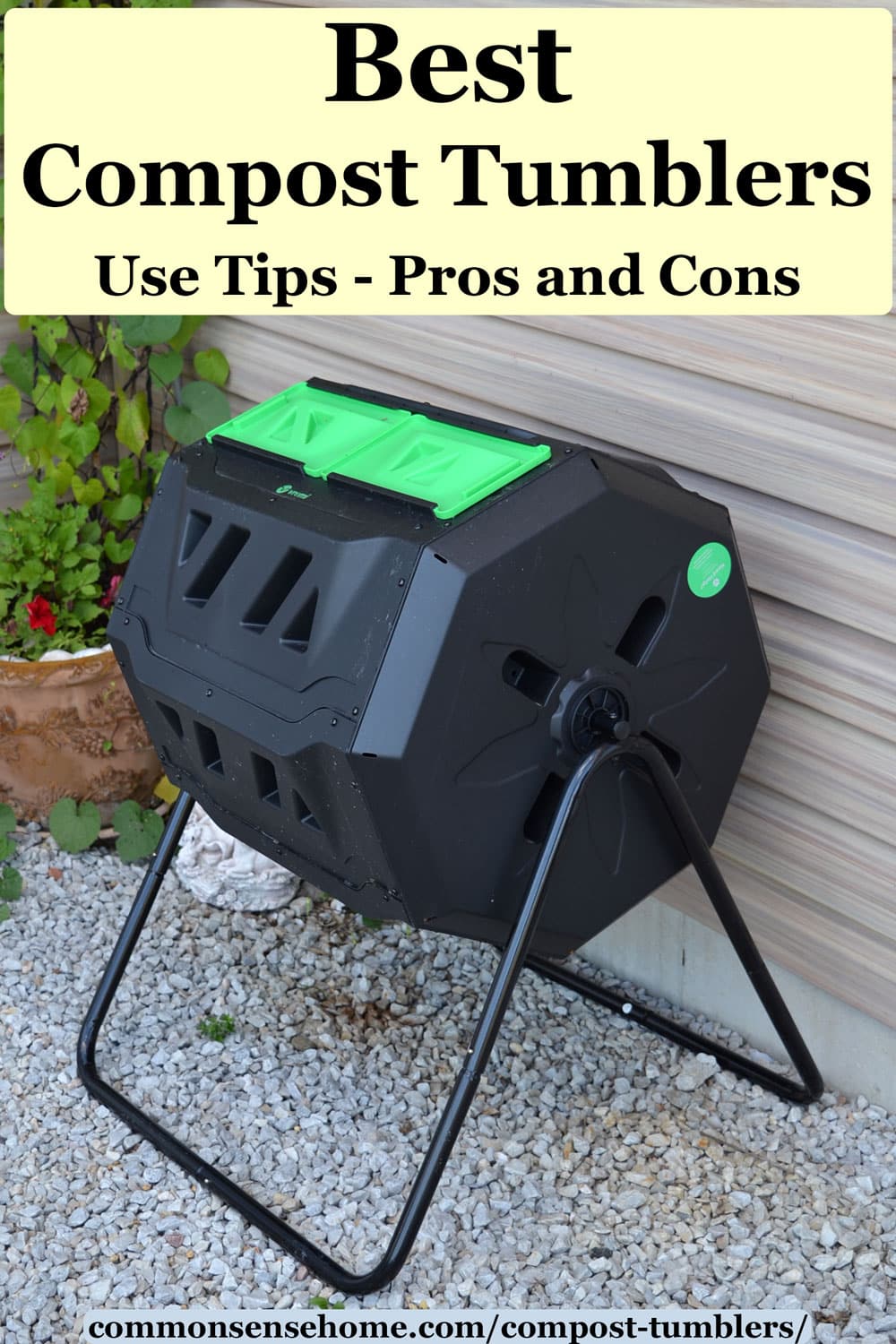
Best Compost Tumblers
Which compost tumbler is best depends on how you want to use it. There are a variety of sizes and styles. These are some of the top options based on online reviews and features.
Vremi Duel Chamber Composting Tumbler

Dual chamber units are my preferred option, because you still have somewhere to put compost while the first chamber finishes composting.
The unit ships flat to save space. (They include an Allen key and small wrench for assembly.) It does take some time to assemble, but more screws means it’s built to hold together.
The doors slide easily to open, and are easy to spot in their contrasting green color. It holds 42 gallons, and is made of UV inhibited polypropylene and powder coated steel.
I was given a unit to try out and it’s holding up well. This size should work well for a family of four with average composting needs.
Common Sense Home readers can get 20% off the Vremi Tumbling Compost Bin through 10/10/21 with coupon code “20CSHOME20”.
Miracle-Gro Small Composter
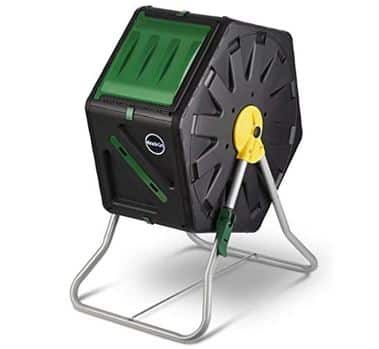
If space is tight, a compact single chamber tumbling composter may be a better option.
The Miracle Gro small composter holds 18.5 gallons, and is small enough to fit on a balcony or patio. Since space is limited, it’s best for households of 1-2 people with light composting needs.
The unit is made of UV resistant plastic, and comes with a pair of gardening gloves.
Jora Large Insulated Compost Tumbler
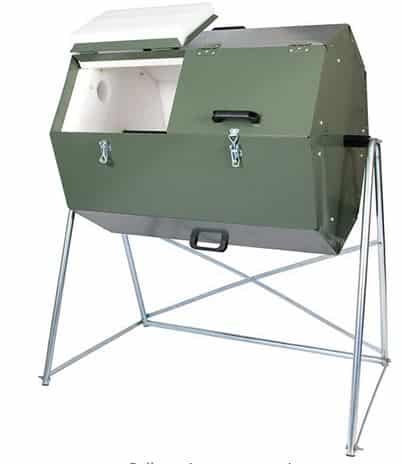
If you live in a cold climate and want a BIG tumbling composter, the Jora units may be right for you. The JK270 holds up to 70 gallons, the JK 400 holds up to 106 gallons.
The large Jora composters are made with insulated galvanized steel for durability. They have dual chambers, so you can let one batch finish while you start another.
Reviews are mixed, with some owners who love them and some owner who had issues with assembly or rust. The units are quite expensive, too, so a regular compost pile may be more cost effective.
Advantages of Compost Tumblers
Tumbling composters cost a bit more then stationary bins, but they have some advantages.
Easy to Turn Compost
I don’t turn my main compost piles, because it’s messy and quite a bit of work. We keep our tumbler near the front door, and family members give it a spin nearly every day. There’s no struggling with a garden fork to flip material (that often falls right through the fork tines).
Less Messy
One big complaint I regularly see about composting is that it’s too messy. With a tumbler, everything is closed inside, making it a good choice for smaller urban and suburban properties.
If space is really tight, you may want to try worm composting inside your home.
Would you like to save this?
Faster Composting
We compost our main piles for about a year, but the right carbon to nitrogen ratio, your compost tumbler can turn out rich compost is as little as three weeks.
Chop waste into smaller pieces, and use a mix of fast rotting and woody materials (greens and browns). Keep your compost “damp sponge” moist and warm, and it will break down quickly.
Less Odor and Less Weed Seeds
As I mentioned above, our compost tumbler is right near our front door. I walk by it daily, and even on steamy days, it doesn’t smell bad. Speedy composting keeps the odor “earthy” instead of “stinky”.
Make sure to use enough “browns” to keep your compost balanced. Browns include dry plant material like leaves, or even shredded plain brown cardboard.
Because your tumbler stays hot and active with regular turning, it should kill off weed seeds and some diseases.
Compost Tumblers Keep Pests Out
Since they are off the ground and enclosed, mice and other marauders can’t easily access your compost. There are even heavy duty bins made of steel that keep out rats and larger animals.
Create Liquid Fertilizer
As your kitchen waste and other materials break down, they naturally give off liquid, which is known as leachate. Some people call it compost tea, but that term is usually used for a different type of fertilizer (see below).
Place a basin below the unit to catch the liquid from your compost tumbler. This leachate makes a great, easy to use liquid fertilizer.
(Note: Another type of “compost tea” is made by soaking finished compost in water. Sometimes the tea is aerated to boost healthy microbe growth.)
Disadvantages of Compost Tumblers
Not every location is a perfect fit for a tumbler. Sometimes compost piles or worm composting work better.
Some cons include:
- Cost – they’re generally more expensive than a standard compost bin, because of the moving parts.
- May take some effort to turn when filled, especially larger units. Some big units have geared crank handles for easier turning.
- Limited capacity – if you have a LOT of compost (like barn or coop bedding), you’ll need more room. Most units hold 50 gallons (6.6 cubic feet) or less.
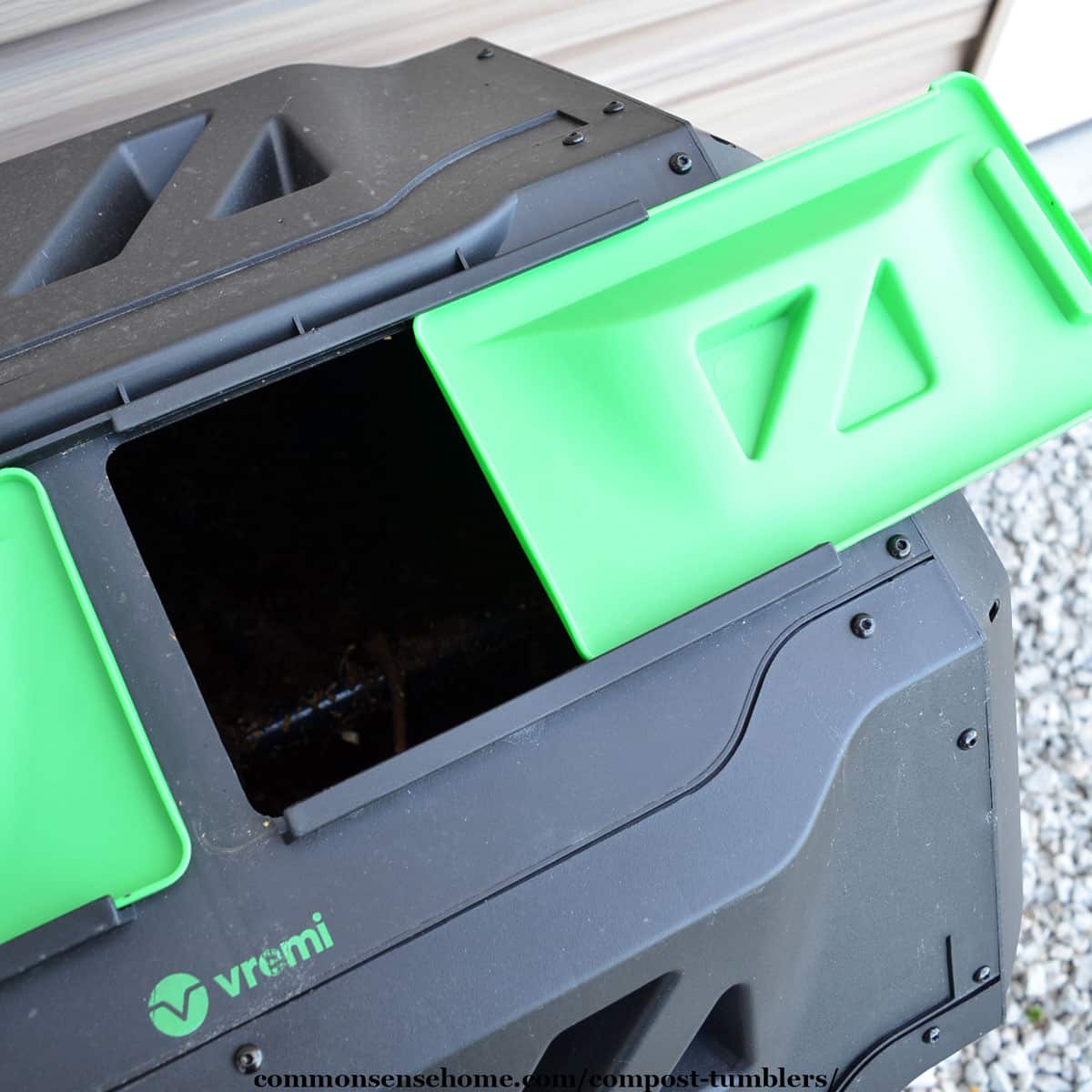
How to Use a Compost Tumbler
- Assemble your compost tumbler, and place it on flat, well drained ground. Make sure it gets some sunlight, and that you have room to spin the drum.
- Load compost materials into the drum. If using a dual chamber composter, load one chamber first, then allow it to finish composting while you fill the other chamber.
- Spin the tumbler several times per week to aerate and mix the compost. Your finished compost should be ready in 2 to 3 months, depending on what you are composting and ambient conditions.
What can I compost?
Use your tumbling composter for organic matter such as:
- sticks
- leaves
- grass clippings
- kitchen scraps
- coffee grounds
- eggshells
- spent plants from flower beds and vegetable gardens
- animal bedding, such as rabbit droppings and coop bedding
Do NOT compost:
- Trash, such as glass, plastic, and metal
- Animal products such as fats, meats, and bone, which may attract more pests
More Gardening Articles
We have over 100 gardening articles on the site to take you from planting to harvest. They’re all listed by category on the Gardening Index page, or you can use the search option in the top menu.
Some of our most popular posts include:
- How to Start a Garden
- Small Garden Ideas – 10 Tips to Grow More Food in Less Space
- Growing Potatoes the Easy Way with Potato Towers
- Soil Testing – 5 Easy Tests for Your Yard and Garden
- Organic Fertilizer – Feed Your Plants, Soil and Microbes
We also have a great assortment of of food storage recipes and preservation tips on the Recipes index page.

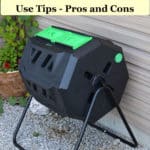
I have a large compost tumbler and a dual chamber one. Both work very well for me and I have been using them for several years. One advantage I want to suggest is have your tumblers on raised stand so it is easy to roll a wheelbarrow under it and just dump the compost. Saves a lot of shoveling. It is easy to make a sturdy stand out of 2 x 4s.